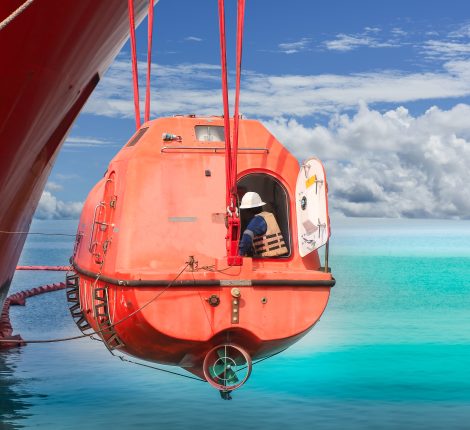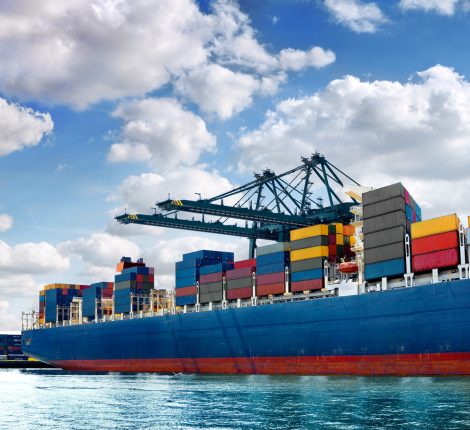- October 24, 2025
- 2025 , Circulars
- Comments : 0
Lifting Appliances and Anchor Handling Winches
C25054 | 14 October 2025
Notice to: Ship Owners/ Managers/ Operators/ Surveyors
At its 107th session, the IMO Maritime Safety Committee adopted:
• Resolution MSC.532(107), which introduces a new SOLAS Regulation II-1/3-13, entering into force on 01 January 2026 and which specifies requirements for the design, construction, operation, testing, and maintenance of lifting appliances, anchor handling winches and associated loose gear.
• MSC.1/Circ.1662 – Guidelines for anchor handling winches.
• MSC.1/Circ.1663 – Guidelines for lifting appliances.
The Maritime Safety Committee has also issued MSC.1/Circ.1696 which gives the unified interpretation of SOLAS regulation II-1/3-13.2.4, for lifting appliances installed before 1 January 2026
SOLAS Regulation II-1/3-13 applies to load-handling equipment that is used:
• for cargo loading, transfer or discharge,
• for raising and lowering hatch covers or moveable bulkheads,
• as engine room cranes,
• as stores cranes,
• as hose handling cranes,
• used for launch and recovery of tender boats and similar applications,
• as personnel handling cranes.
The Regulation does not apply to:
• lifting appliances installed on ships certified as Mobile Offshore Drilling Units (MODUs),
• lifting appliances used on offshore construction ships, such as pipe/cable laying/repair or offshore installation vessels, including ships for decommissioning work, which comply with standards acceptable to the Flag Administration,
• integrated mechanical devices solely intended for opening or closing hatch covers, and
• life-saving launching appliances covered under the Life-Saving Appliances (LSA) Code.
Points to Note:
New Lifting Appliances and Loose Gears installed on or after 01 January 2026:
• The design, construction and installation are to be per the requirements of the vessel’s RO, based on MSC.1/Circ.1663.
• The load test & thorough examination are to be carried out after installation and before being used for the first time, and after repairs, modifications or alterations of a major character.
• The SWL is to be permanently marked and provided with documentary evidence for the SWL.
• For Lifting Appliances with SWL below 1000 Kg, the Flag Administration will decide the application of provisions of the above requirements.
New Anchor Handling Winches and Loose Gears installed on or after 01 January 2026:
• Anchor handling winches and loose gear installed on or after 1 January 2026 are to be designed, constructed, installed and tested to the requirements of the vessel’s RO, based on MSC.1 / Circ.1662.
• The commissioning test & thorough examination are to be carried out after installation and before being used for the first time, and after repairs, modifications or alterations of a major character.
• Anchor handling winches are to be properly marked with any restrictions associated with their safe operation.
Existing Lifting Appliances installed before 01 January 2026:
• The load test & thorough examination are to be carried out, and the SWL is to be permanently marked and documentary evidence for the SWL provided not later than the date of the first Safety Construction Renewal Survey on or after 1 January 2026.
• Existing lifting appliances with valid certificates of test and thorough examination under another international instrument acceptable to the Flag Administration (e.g. ILO Convention No. 152) and issued before 01 January 2026 are considered compliant with the requirement.
• Where the SWL of the lifting appliances is undocumented and design information is not available, and the manufacturer no longer exists, the test load is to be calculated using Table 1 of MSC.1/Circ.1663, based on a SWL nominated by the company, to the satisfaction of the vessel’s RO.
• For existing lifting appliances without valid certificates of test and thorough examination acceptable to the Flag Administration, compliance with SOLAS regulation II-1/3-13.2.4 may be demonstrated by means of a “factual statement” (also known as a “statement of fact”), issued by the competent person approved by the Flag Administration, or the recognized organization (RO). A sample form of the factual statement is included as an appendix to MSC.1/Circ.1696.
• The factual statement form should be different from the form used to confirm compliance with SOLAS regulations II-1/3-13.2.1 and 3-13.2.3. The Sample Certificate should not be used to confirm compliance with SOLAS regulation II-1/3-13.2.4.
• The factual statement may be attached to the form “Register of lifting appliances and cargo handling gear”, provided it clearly refers to documenting compliance with SOLAS regulation II-1/3-13.2.4 only.
• It should be made clear in the factual statement that the competent person approved by the Flag Administration, or an RO, has confirmed that the test load has been calculated based on a SWL nominated by the company, to the satisfaction of the Flag Administration and that the SWL is not confirmed by the competent person.
Existing Anchor Handling Winches and Loose Gears installed before 01 January 2026:
• Anchor handling winches installed before 1 January 2026 are to be tested and thoroughly examined, based on MSC.1/Circ. 1662 and properly marked with any restriction associated with their safe operation, no later than the date of the first Safety Construction Renewal Survey on or after 1 January 2026.
• Existing anchor handling winches with valid certificates under another international instrument acceptable to the Flag Administration and issued before 01 January 2026 are considered compliant with the requirement.
Requirements applicable to both New and Existing Lifting Appliances (irrespective of the date of installation):
• Lifting appliances are to be load retested at least once every five years (or after major repairs, modifications, or alterations).
• Lifting appliances are to be subject to thorough examination upon completion of any load test, and annually.
• All loose gear in use with lifting appliances is to have documentary evidence of a proof test and be retested after repairs, modifications or alterations of major character acceptable to the Flag Administration.
• Lifting appliances are to be provided with an Operation Manual and Maintenance Manual by the manufacturer. Where these manuals for existing lifting appliances are not available from the manufacturer, they may be provided by competent third parties.
• Records of the routine inspection and maintenance of lifting appliances or their components, or parts, are to be maintained and kept on board.
• All personnel involved in the operation of lifting appliances must be properly trained, qualified and familiarized in handling the equipment.
• If, on completion of an inspection, the lifting appliance is considered unsafe for operation or not in compliance with applicable requirements, then:
• It should be taken out of service until any deficiency is rectified to the satisfaction of a competent person.
• It should be clearly marked “not to be used”, and the status should be recorded in a lifting appliances register.
• To mitigate risks posed by inoperative lifting appliances, the Master should:
• Take the inoperative lifting appliance into account in planning and executing a safe voyage.
• Prevent operation of inoperative lifting appliances.
• Prevent uncontrolled movement of inoperative lifting appliances or their components using appropriate restraining and preventing arrangements, if required.
• Store inoperative loose gear separately from in-service loose gear and mark it as being inoperative.
• Record any inoperative lifting appliance or loose gear in the register of the ship’s lifting appliances until necessary repairs have been completed and it has been load tested or proof tested, as necessary, and thoroughly examined.
Requirements applicable to both New and Existing Anchor Handling Winches (irrespective of the date of installation):
• Anchor handling winches and associated equipment are to be operationally tested annually and five yearly. The annual test is to include function tests of all equipment. Five-yearly testing is to be witnessed by the Flag Administration/RO.
• Thorough examination of anchor handling winches and associated equipment is to be carried out every year.
• Annual Thorough Examination of Anchor handling winches and associated equipment is to be carried out during the Annual surveys, before re-entering service after any structural repairs or modifications of major character and after load testing.
• All loose gear in use with anchor handling winches and associated equipment is to have documentary evidence of a proof test and be retested after repairs, modifications or alterations of major character acceptable to the Flag Administration.
• Anchor handling winches are to be provided with an Operation Manual and Maintenance Manual by the manufacturer. Where these manuals for existing anchor handling winches are not available from the manufacturer, these may be provided by competent third parties.
• Records of the routine inspection and maintenance of anchor handling winches or their components, or parts, should be maintained and kept on board.
• Personnel operating anchor handling winches and their associated equipment are to be qualified, familiarized with the equipment and authorized by the master.
• If, on completion of a thorough examination, the anchor handling winch is considered to be unsafe for operation or not in compliance with applicable requirements, then:
• It should be taken out of service until any deficiency is rectified to the satisfaction of a competent person.
• It should be clearly marked “not to be used”, and the status should be recorded.
• To mitigate risks posed by inoperative anchor handling winches and associated loose gear and wire, the Master should:
• Take the inoperative anchor handling winches, associated equipment and wire into account in planning and executing a safe voyage.
• Prevent the operation of inoperative anchor handling winches and associated loose gear and equipment.
• Prevent uncontrolled movement of inoperative anchor handling winches or associated loose gear and equipment using appropriate restraining and preventing arrangements, if required.
• Store inoperative wires and loose gear separately from in-service wires and loose gear and mark them as being inoperative.
• Record the particulars of anchor handling winches or loose gear, associated equipment and wire that is inoperative until necessary repairs have been completed and it has been tested or proof tested, as necessary, and thoroughly examined.
Nameplates
Anchor handling winches should be provided with a permanently affixed name plate which should include at least the following information:
• details of the manufacturer (name, address),
• model name/number,
• serial number,
• date of manufacture and date of installation,
• details of power supply,
• details of wire (e.g. length, diameter,
• maximum brake holding capacity, metric tons,
• maximum line pull, metric tons,
• maximum static bollard pull, metric tons,
• placeholder for the classification society’s surveyor’s stamp,
• drum size, and
• winch speed.
Act now
Ship Owners/ Managers/ Operators/ Surveyors should take note of the contents of Resolution MSC.532(107) and MSC.1/Circ.1696 as well as the associated guidelines and be guided accordingly.





